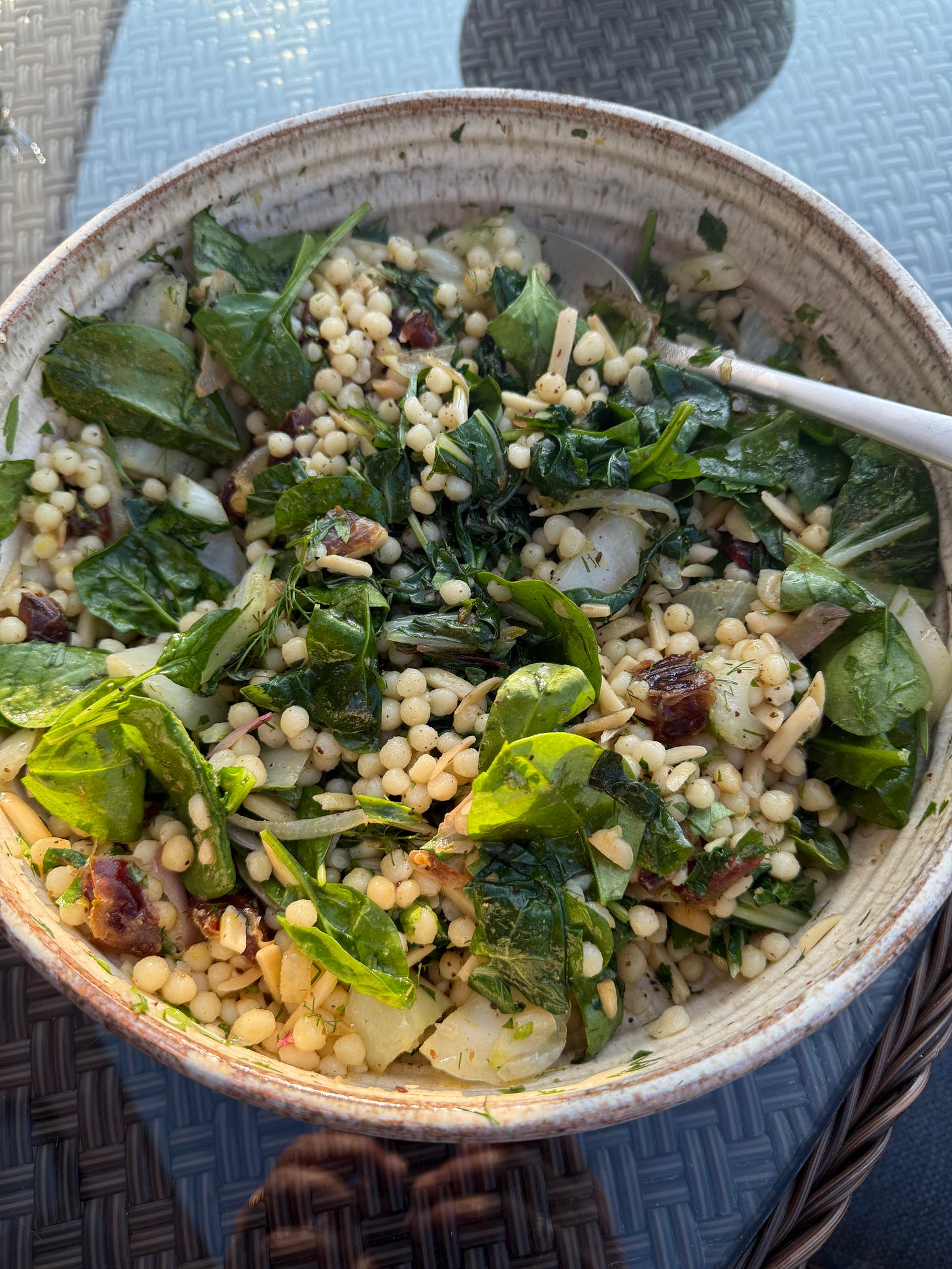Olivia came home recently for a short break. She's almost always either training or travelling the world for rugby. When I know she’s coming, I like to prepare a variety of snacks she can easily grab, whether she’s hungry or heading out to train. The usual lineup includes hummus, whipped feta, boiled eggs, cooked beets, a mix of nuts and seeds, and grilled tofu, all ready and waiting for her.
We often cook together when she’s home, planning meals, gathering ingredients, and leaving space to improvise as we go. I constantly feel like I’m searching for inspiration in the kitchen. I get tired of making what feels like the same old things. Recently, I was at a lovely restaurant that served Middle Eastern food, and the breakfast I ordered was simple; I’ve been trying to recreate it ever since: poached eggs on homemade bread, layered over thick yogurt. Alongside, tiny dishes of za’atar, olive oil, and flaked salt. I already have these ingredients at home, but being served them separately to add myself felt refreshingly different, and it was delicious. I could taste each element on its own, the spice, the salt, the oil. So good.
Clearing the deck
When Olivia has a break in rugby schedule, I always clear the calendar. It’s most often not a very long visit so her sisters and I treasure the time. This break involved a trip to Toronto to speak with various media and I opted to be a chauffeur having the car ride there and back and just being in her orbit of conversation with lots of people. I toodled around the St. Lawrence market which is full of fantastic food vendors, some of them there since I moved to Toronto back in the early 1980’s. No problem in finding inspiration for things to bring home and add to our meals.
Diet of an athlete
Olivia is so intentional about what she eats, when she eats, how ingredients combine, proteins, carbs... I can’t keep track. I’m always learning something new. When she was home last, she told me to start taking creatine to help maintain muscle strength and improve bone health, and naturally, I did. This visit, she mentioned it’s best taken with carbohydrates. Good to know. She recommended a protein powder, of course I ordered it. We also shared some morning power smoothies she makes herself when she can: unsweetened cocoa, spinach, almond butter, protein powder, big chunks of fresh ginger, dark cherries, and coconut milk. Delicious. I’m still making them even though she’s gone. With a bit of intentional shopping and gathering ingredients I mostly already have at home, I feel good, and healthy, in her wake.
Changing things up
When Liv was here, I wanted to create the interesting restaurant vibe I recently experienced and I put small bowls on the table filled with things to add on top, seeds and nuts, fresh herbs, spices, flaked salt, and infused oils with chili or lemon. We kept the cooking simple. For example, we grilled halibut with just salt and pepper, then added fresh herbs and a touch of salt once it was on the plate and still hot enough for the flavors to melt in. The little bowls let us jazz things up however we liked. It’s actually a fun way to entertain, too, guests can choose what they want and how much.
Her turn to cook
One evening she wanted to make a couscous salad that she often makes when she’s home in Victoria. I suggested we could add kale from my planter on the patio and was also given some bok choy and other greens. Her recipe has cardamom, sumac, za’atar, cumin. Mine, just sumac and lemon. First she sautes shallots in olive oil, she adds almonds and spices. She takes this mixture out and then sautes the cooked couscous in olive oil and salt and adds lemon zest and lemon juice. She adds chopped dates that she has let sit in a bit of lemon juice and adds it to the couscous. She tops hers off with pomegranate molasses. Classically we never follow one way of making something, I improvised with what I had on hand into how she makes it and it was delicious.
What type of couscous to use?
I had some Lebanese couscous that I initially thought was similar to Israeli or pearl couscous. But the texture is quite different, it’s like eating the large type of tapioca pudding and less nutty than Israeli couscous, which is toasted. I had picked it up during a trip to Brooklyn over the holidays, in a neighborhood filled with amazing shops offering all kinds of foods and spices. The store specialized in Middle Eastern ingredients, and the couscous caught my eye. Apparently, Lebanese couscous is hand-rolled from semolina flour and dried, not toasted like the Israeli or pearl version. It is also the size of a pea versus the pearl couscous which is like a lentil.
We quickly discovered when we were cooking the Lebanese couscous, that the two are not the same. The regular small couscous takes about 15 minutes to cook, simmered in water and finished with a quick steam. The pearl couscous, a bit longer, maybe 20-30 minutes. I figured a few extra minutes would be enough for this version. But after about 30 minutes, it started to resemble porridge and still wasn’t fully cooked. We added more water and let it simmer longer. Even after 45–60 minutes, it was only just starting to seem done. The water had turned starchy, and I worried it might end up gummy and sticky. We gave it a good rinse, held our breaths and tossed it into a waiting salad bowl.
We didn’t sauté it in olive oil as Olivia most often does. Instead, we had all the ingredients ready, and simply added the warm couscous straight in. It was absolutely delicious.
This dish makes a perfect summer salad, but with heartier, cold-weather vegetables, it would also be a lovely side for roast chicken or lamb in winter.
Liv and I came up with this dish together, and the best part was the leftovers, we had them for lunch the next day with boiled eggs, fresh arugula, a squeeze of lemon, and of course, whipped feta.
Liv and Danielle’s couscous side
Serves 4-6
1 ½ cup of cooked couscous. The kind is up to you!
4 tablespoons olive oil
2 cups of chopped, sturdy greens like kale, spinach, bokchoy or a mixture of everything
2 shallots sliced
Zest of 1 lemon
Juice of 1 lemon (maybe more to taste)
1 tablespoon sumac
½ tsp cardamom (optional on my version)
1 tsp za’atar (served on the side)
½ c sliced almonds
6 - 8 large dates sliced and soaked in 1 tablespoons of lemon juice for 15 minutes
1 bunch chopped fresh parsley (optional)
Cook the couscous as per the instructions on the package. Set aside.
In a shallow skillet big enough to hold everything, saute the shallots in 2 tablespoons of olive oil. When they are soft add the nuts and saute about 2 more minutes. Add the cardamom, sumac and the greens just to wilt - about 1 minute. Remove from the pan.
In a large bowl add all the ingredients - dates, couscous, greens and shallot mixture and toss. Add salt and pepper. Add in lemon juice and the 2 tablespoons of olive oil. Taste and adjust.
We served this with grilled halibut and sliced tomatoes in olive oil and basil.
In the winter, you can substitute roasted carrots and parsnips and serve the dish warm.





